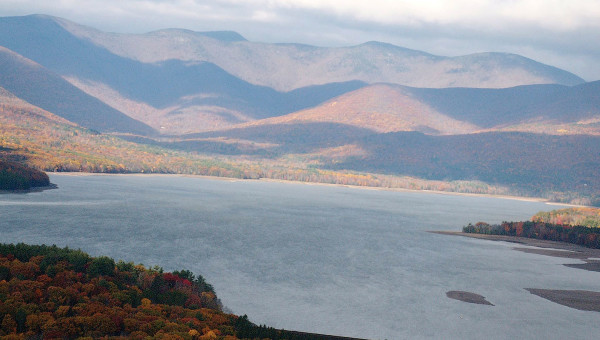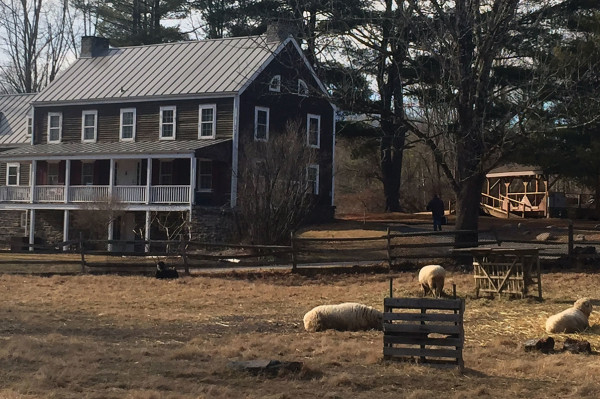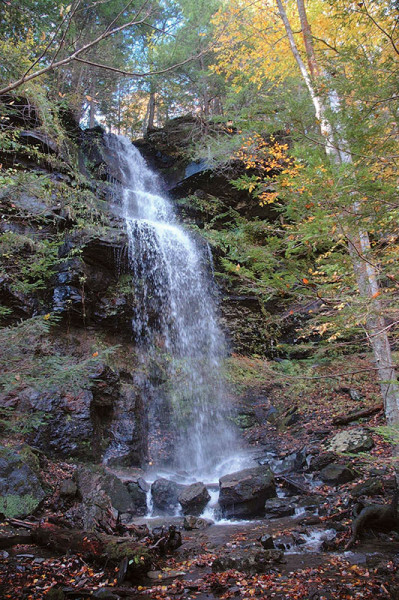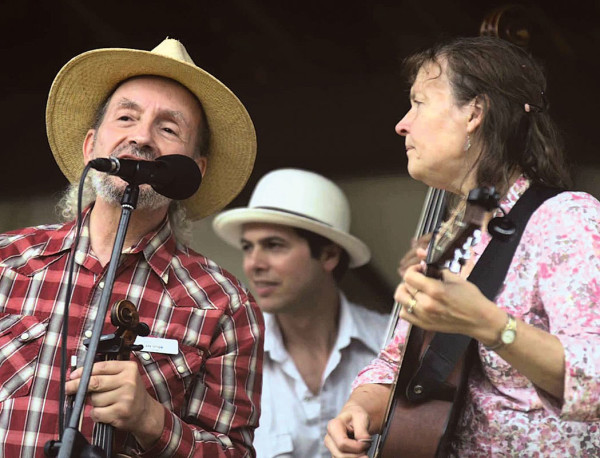
The vast Ashokan Reservoir in New York’s Catskills shares a name and some history with the Ashokan Center. (Photo by Cindy Wallach)
Inside the old pewter shop at twilight, Molly Mason pauses between waltzes to muse aloud about how lovely it would be to hold a pre-holiday event in the soon-to-be-restored building, which has remarkable acoustics. As she and her partner, Jay Ungar, launch into a tune called “Cabernet”—he on fiddle, she on guitar—a man knitting a cap at the end of a timeworn, spindle-back bench hums along, while people nearby tap their feet.

Sheep take their ease in front of the 18th-century Winchell Farmhouse. (Photo by Cindy Wallach)
Spontaneity, especially of the musical kind, bubbles just below the surface at the Ashokan Center. Nestled in New York’s Catskill Mountains, this 385-acre center, in a landscape of farmland and rugged hills, was organized nearly 50 years ago. Kent Reeves, a professor at nearby SUNY–New Paltz, founded the first Living History programs in the state here, in 1967.
Now this place of waterfalls and hiking trails is home to a modern eco-friendly campus, historic structures, and buildings intentionally constructed using old methods—some now approaching “historic” status in their own right. A decade ago, a partnership provided funds for the relocation of some creek-side buildings to higher ground, and for construction of sustainably designed new buildings that include a performance hall, dining room, classroom spaces, and lodging for 150 guests. Each year, the Center welcomes thousands of people to its educational programs, music and dance camps, festivals, retreats, and craft events.
The heart of the curriculum is hands-on environmental, colonial history, adventure, camping, and homesteading programs for schoolchildren, held spring and fall. Programming for folks of all ages overlaps delightfully at the camps and through concerts and community events like the twice-yearly “Hoots” begun in 2013 by Ruthy Ungar, Jay’s daughter, and her husband and musical partner Mike Merenda.

A waterfall on the 385-acre campus. (Photo by Cindy Wallach)
World-class folk and Americana musicians from across the country draw hundreds of happy listeners to these multi-day festivals, from small children dancing in the grass to great-grandparents relaxing in the shade on Hoot Hill.
The Hoots are a natural outgrowth of the Ashokan Music and Dance camps, begun in 1980 by the elder Ungar. Weekend and week-long sessions allow participants to immerse themselves in acoustic guitar or ukulele, the culture of musical traditions (“Northern” and “Southern” weeks), and traditional folk dance and culture (“Western and Swing” week).
Everyone has a blast. “It’s fun to walk down the halls during a music week,” says Martin Bernstein, the Center’s development director. “You can hear 100 different people on 100 different instruments jamming and having a good time.” The Ashokan Center, Olivebridge, NY: (845) 657-8333, ashokancenter.org

On fiddle and guitar, Jay Ungar and Molly Mason lead music camps at Ashokan. (Photo by Cindy Wallach)
Ashokan Farewell
In 1982, the musician Jay Ungar was coming off a summer of traditional music camps at Ashokan when, feeling melancholy, he wrote the bittersweet hymn that would become the theme for Ken Burns’ series “The Civil War.”
At first, Ungar says, he could barely play the tune on his fiddle without crying. He would discover that the song resonates with many people, from President George W. Bush, who invited Ungar to perform it at the White House, to a Mexican woman deep in the Yucatan, whose face streamed with tears when she heard him play the tune.
Named “Ashokan Farewell” at the suggestion of his wife and partner, Molly Mason, the song forged an unlikely link with then-Governor George Pataki when the Center’s existence was threatened by a possible land sale a decade ago. Pataki, who admits to “choking up” when he heard the song, helped the Center by providing its leaders time to raise funds and set up nonprofit status. Details were worked out through a coalition with the Open Space Institute and the City of New York, which manages the Ashokan Reservoir.
When he wrote the song, Ungar was thinking neither of the Civil War nor about the residents who lost their homes when the reservoir flooded the area a century ago. “Then I read their bitter stories,” he says. “It was as though someone had spoken through me.”







